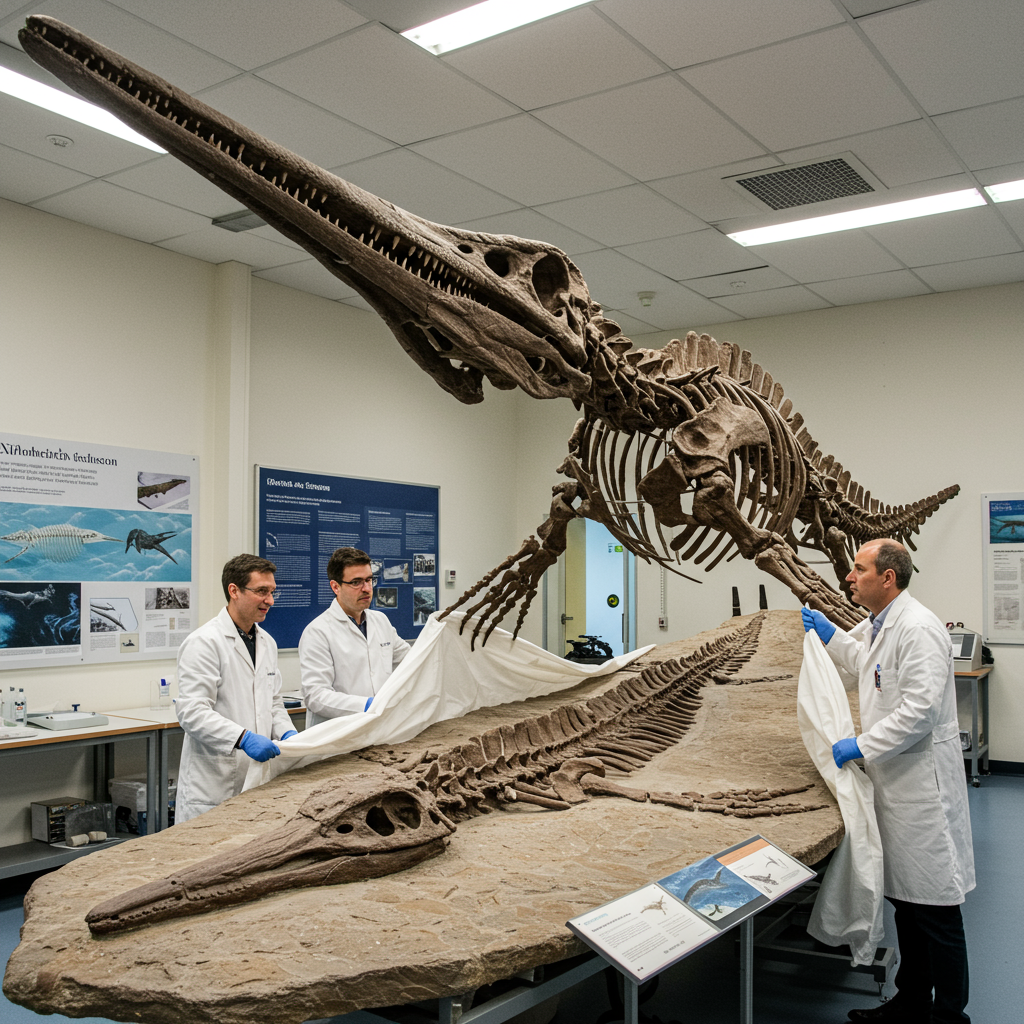The ancient oceans held countless mysteries, and every fossil discovery peels back another layer of Earth’s incredible past. Palaeontologists have recently unveiled a spectacular “missing piece” from the Early Jurassic era: a formidable marine reptile officially named Xiphodracon, or “Sword Dragon.” This extraordinary ichthyosaur, identified after decades of meticulous research, offers unprecedented insights into a pivotal yet poorly understood chapter of marine evolution, dramatically reshaping our understanding of life during the Pliensbachian age.
The Dawn of the Sword Dragon: A Jurassic Coast Revelation
The journey of Xiphodracon began not in a laboratory, but on the rugged, fossil-rich cliffs of England’s world-renowned Jurassic Coast. In 2001, dedicated local fossil hunter Chris Moore unearthed a remarkable, nearly complete skeleton near Golden Cap, Dorset. This specimen, destined to become a cornerstone of ichthyosaur research, was subsequently acquired by the Royal Ontario Museum in Canada, where it remained largely unstudied for over a decade, its profound significance still unrecognized.
It wasn’t until 2016 that the fossil’s true potential began to emerge. Dr. Dean Lomax, a prominent palaeontologist from the University of Manchester, encountered the specimen and immediately recognized its highly unusual characteristics. His keen eye ignited a new era of research, drawing a team of experts, including Professor Judy Massare from the State University of New York and Dr. Erin Maxwell from the State Museum of Natural History Stuttgart, to meticulously analyze the ancient remains.
From Overlooked Fossil to Evolutionary Cornerstone
Dr. Lomax vividly recalled his initial impression of the skeleton. “I knew it was unusual,” he stated, “but I did not expect it to play such a pivotal role in helping to fill a gap in our understanding.” That gap, as researchers would soon discover, was a substantial one in the ichthyosaur evolutionary record, particularly concerning the Pliensbachian stage of the Early Jurassic. The subsequent bone-by-bone analysis by the international team ultimately confirmed that this specimen was indeed a unique species, never before documented. This discovery was officially published in Papers in Palaeontology, cementing Xiphodracon as a crucial “missing piece” of the ichthyosaur puzzle.
Unpacking Xiphodracon: Anatomy of an Ancient Apex Predator
The formal naming of a new species is always a momentous occasion for palaeontologists. Dr. Lomax and his team thoughtfully christened the creature Xiphodracon goldencapensis. The name itself is a testament to the animal’s striking features and historical context. “Xiphodracon” translates to “sword dragon,” derived from the Greek word “xiphos” (sword) and “dracon” (dragon). This choice elegantly references its most distinguishing feature: a remarkably long, narrow, and sword-like snout. The “goldencapensis” suffix pays homage to Golden Cap, the specific location in Dorset where it was discovered.
This ancient marine reptile, estimated to have roamed the seas between 193 and 184 million years ago, was roughly the size of a modern dolphin, measuring approximately 10 feet (3 meters) in length. Its skull featured enormous eye sockets, suggesting excellent vision, crucial for an animal navigating the dimly lit depths of the prehistoric ocean. Like many ichthyosaurs, Xiphodracon was a formidable predator, its distinctive snout and sharp teeth perfectly adapted for snatching fast-moving prey such as fish and squid from the water.
Unique Features and a Violent End
Beyond its defining sword-like snout, Xiphodracon possesses several anatomical quirks previously unseen in other ichthyosaur species. Most notably, researchers identified a mysterious prong-like bony bump situated near its nostril on the lacrimal bone. The precise function of this unique structure remains a subject of ongoing scientific inquiry, possibly related to breathing, streamlining, or an unknown sensory perception, hinting at a greater anatomical diversity among ichthyosaurs than previously understood.
The well-preserved fossil also offers a vivid, albeit tragic, glimpse into the individual’s life and dramatic demise. Scientists observed malformations in its limb bones and teeth, indicating that the Xiphodracon endured periods of serious injury or disease during its lifetime. Furthermore, the skull bears unequivocal bite marks, strongly suggesting it met a violent end from an attack by an even larger predator, likely another ichthyosaur. This stark evidence underscores the perilous and often brutal conditions faced by marine life in the Mesozoic oceans.
Bridging the Pliensbachian Gap: Xiphodracon’s Evolutionary Significance
The true scientific importance of Xiphodracon lies in its chronological placement. It is considered the most complete prehistoric reptile from the Pliensbachian stage of the Early Jurassic, a geological period notoriously sparse in ichthyosaur fossils. This era was a critical juncture for ichthyosaur evolution, marked by significant faunal turnover where several older families went extinct, and new ones emerged. For over a century, palaeontologists noted a puzzling disparity: thousands of ichthyosaur skeletons from periods before and after the Pliensbachian, yet a frustrating scarcity from within the period itself. This left a significant void in understanding the evolutionary transitions.
Professor Judy Massare highlighted this conundrum, noting that while the faunas before and after the Pliensbachian were distinct with no common species, the mechanisms driving this evolutionary shift remained unclear. Xiphodracon now provides crucial evidence, demonstrating that this significant “turnover,” where older ichthyosaur clades were replaced by newer ones, began earlier than previously thought. Its strong affinities to taxa from the later Toarcian age suggest a more gradual evolutionary shift rather than an abrupt one. This helps to pinpoint when the change in species diversity occurred.
The Enduring Mystery of Ichthyosaur Turnover
While Xiphodracon provides an essential temporal anchor for this evolutionary transition, the precise why behind the Pliensbachian ichthyosaur turnover remains an open question. Potential causes include significant climatic shifts, changes in sea temperature, or increased competition for food resources. Future research will undoubtedly leverage the insights from Xiphodracon to explore these environmental drivers, further refining our understanding of marine ecosystems during this dynamic period.
A Testament to Palaeontological Perseverance
The remarkable journey of Xiphodracon from an overlooked museum specimen to a pivotal scientific discovery underscores the immense value of museum archives and the dedication of palaeontological researchers. It highlights how even seemingly unremarkable fossils, when re-examined with fresh perspectives and new techniques, can hold the keys to profound scientific puzzles. The specimen is currently housed at the Royal Ontario Museum and is slated for public display in the near future, allowing enthusiasts to witness this “Sword Dragon of Dorset” firsthand.
Beyond rewriting parts of the ichthyosaur family tree, this research offers a broader lesson. It reminds us that radical evolutionary transformations can occur slowly and subtly, not always through abrupt cataclysms. This insight holds relevance for understanding current changes in marine ecosystems, biodiversity, and extinction patterns in our modern era, reinforcing the interconnectedness of Earth’s past and present. The discovery of Xiphodracon clarifies a substantial gap in palaeontological knowledge, but as with all great scientific endeavors, it also opens doors to new questions, inspiring continued exploration of our planet’s ancient seas.
Frequently Asked Questions
What is Xiphodracon, and why is its discovery so important?
Xiphodracon, meaning “sword dragon,” is a newly identified species of ichthyosaur, a marine reptile that lived in the Early Jurassic period, specifically between 193 and 184 million years ago. Its discovery is profoundly important because it represents the most complete prehistoric reptile ever found from the Pliensbachian stage. This period was a critical, yet poorly documented, time for ichthyosaur evolution, marked by significant species turnover. Xiphodracon acts as a crucial “missing piece” of the fossil record, helping palaeontologists understand when major evolutionary shifts occurred in these ancient “sea dragons.”
Where can I see the Xiphodracon fossil, and who were the key researchers involved?
The nearly complete Xiphodracon fossil was originally discovered by local fossil hunter Chris Moore in 2001 near Golden Cap on England’s Jurassic Coast, Dorset. It is currently housed at the Royal Ontario Museum in Canada and is expected to go on public display there in the near future. Key researchers who identified and studied Xiphodracon include Dr. Dean Lomax from the University of Manchester, Professor Judy Massare from the State University of New York, and Dr. Erin Maxwell from the State Museum of Natural History Stuttgart.
What unique physical characteristics did Xiphodracon possess, and what does it tell us about ancient marine life?
Xiphodracon was roughly 10 feet (3 meters) long, with enormous eye sockets and a distinctive, elongated sword-like snout, which inspired its name. Uniquely, it possessed a prong-like bony bump near its nostril, a feature unseen in other known ichthyosaurs. The fossil also shows signs of severe injury or disease during its life, and bite marks on its skull strongly suggest it was attacked and likely killed by a larger predator, possibly another ichthyosaur. These details paint a vivid picture of a perilous Mesozoic ocean, highlighting the diverse anatomies and the brutal realities of survival for ancient marine life during the Early Jurassic era.




